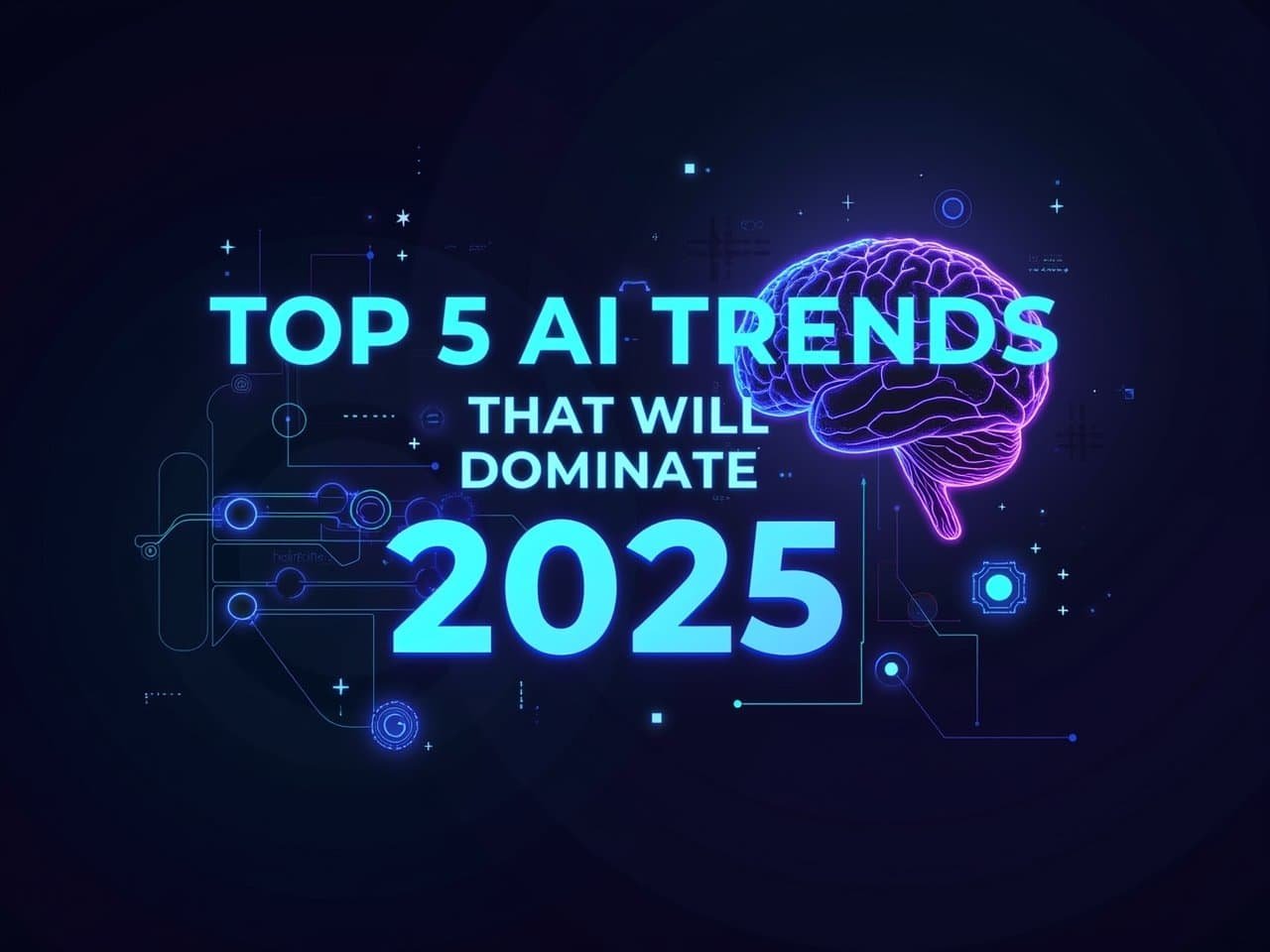With the ten-year passage of time, momentum in AI growth is building, and 2025 will prove to be an epoch-making year under the brand AI Trends 2025. Top 5 AI Trends That Will Dominate 2025 are dealt with in this article, emphasizing their possible impact.
AI-Powered Automation Across Industries
Automation has been around for a while, but the use of advanced artificial intelligence is taking it to new extremes. Artificial intelligence-based automation goes beyond rule-based operation; it enables systems to learn, adapt, and carry out complex processes with minimal or no human intervention. Smart automation will grow exponentially across all sectors by 2025.
- Manufacturing: AI optimizes supply chains, improves machine predictive maintenance to avoid expensive downtime, and powers collaborative robots (cobots) that share the workspace safely with humans, improving factory floor productivity and accuracy.
- Healthcare: AI automation facilitates administrative processes such as scheduling, billing, and data entry, allowing healthcare professionals to dedicate more time to attending to patients. AI is also used to automate the initial medical image diagnosis, allowing for faster diagnoses.
- Finance: Smart systems automate fraud detection through real-time monitoring of transaction patterns, speed up loan processing through rapid analysis of applications, and automate compliance screening.
- Customer Service: Sophisticated AI robots and virtual assistants can now answer a range of consumer queries and support activities, with decreased operating costs and quicker response times.
According to a FlowForma report, sectors such as energy, financial services, healthcare, construction, manufacturing, education, and pharma are already gaining substantial benefits through AI automation by 2025, with cost savings, improved efficiency, and improved results.
Generative AI Evolution (Beyond ChatGPT)
Public accessibility of models such as ChatGPT has promoted AI from generation to generation towards mainstream prominence on the promise to generate text, images, and other content in human-like form. Through 2025, advancement of creative AI will continue to outrun such early applications to further embed, specialize, and multiply.
- Deep Integration: Future AI capabilities will be deeply embedded in more software applications and workflows employed by individuals and companies on a daily basis, enabling greater convenience in content creation, synthesis, and analysis.
- Multimodal Advances: Future AI systems will increasingly support the simultaneous generation of content across multiple modalities—text, images, audio, and video—to enable more imaginative and contextual applications.
- Expert Models: Expert AI models that are trained in a specific sector or industry (such as law, medicine, and scientific studies) that deliver very accurate and context-specific output for specialized use.
- AI Agent: The concept of AI agents being able to reason, plan, and take action at several stages with minimal human intervention will gain momentum, going beyond content generation to autonomous action.
McKinsey estimates the potential addition to the world economy every year in billions of dollars as it points to a potential revolution to come.
AI in Healthcare and Diagnosis
The healthcare industry is poised for AI conversion, and great breakthroughs are anticipated by 2025, especially in diagnostics and personalized medicine. The capacity of AI to process intricate biological and medical data is beneficial.
- Faster Diagnosis: AI software is capable of processing medical images such as X-rays, MRIs, and CT scans, and patient data at phenomenal speeds and identifying faint patterns too faint to be recognized by the human eye, thus speeding up and enhancing diabetes and cancer diagnosis.
- Drug Development and Discovery: Artificial intelligence significantly speeds up the pace at which potential candidates are discovered, the disease pathology is realized, the efficacy and safety of novel compounds are anticipated, and time and cost are saved in getting new drugs to the marketplace.
- Personalized Medicine: By the analysis of a patient’s genetic profile, medical history, and life characteristics, AI can personalize treatment regimens and predict the way patients would respond to therapies, leading to more customized and enhanced healthcare.
- Automated Medical Coding and Documentation: More and more medical professionals are turning to artificial intelligence to perform the time-consuming task of clinical coding and the compilation of patient records, to streamline processes while liberating paperwork needs medical staff from.
Experts indicate that by 2025, AI will be “standard adoption” in patient-facing roles, initially in operational support and data processing roles, before broader clinical applications become commonplace.
AI Ethics and Governance Frameworks
Where there is more power and ubiquity of AI, there is a need to come up with robust ethical standards and governance frameworks. 2025 will also prove to be a critical year to make choices about standards and laws so that AI can be responsibly constructed and applied as well as shared equitably.
- More Regulation: Governments and international agencies are already actively trying to regulate AI. Throughout the year 2025, more explicit regulation related to AI usage, especially during high-stakes situations, is likely.
- More Focus on Explainability and Transparency: More focus on transparent and explainable AI to create greater insight into decision-making in AI systems and to facilitate the building of accountability and trust, especially for such critical sectors as finance and health care.
- Algorithmic Fairness: There will be more efforts in the direction of detection and prevention of algorithmic bias in AI systems. Mechanisms and tools must be brought in to ensure fair treatment of AI output.
- Privacy and Data Security: Since AI is so data-intensive, there will be a need to develop regimes of data privacy and cybersecurity practices, specifically for AI systems, to protect personal data.
Platforms such as the NIST’s AI Risk Management Framework and European AI Law set the pace for the future and for 2025 planning that the government AI is doing.
Edge AI and On-Device Intelligence
The trajectory of work to grow closer to its source and less in single-breadboard dependence on far-cloud computing continues to push, ushering on-device and Edge AI into flower. There will be more processing either on devices or at the “edge” of the network in 2025.
- Reduced Latency: Mission-critical, real-time decision-making in areas like autonomous automobiles, industrial automation, and intelligent security will be supported by local processing where latency is destructive.
- More Privacy: Local processing reduces the amount of data to be transmitted to the cloud and hence ensures greater user data security and privacy.
- Reduced Bandwidth: Edge-level analysis reduces the amount of data that must be communicated over networks, reducing bandwidth needs and costs.
- Improved Flexibility: Edge AI products can run on or off cloud connectivity, which makes them more reliable in different environments.
From wearable health sensors and smart cameras to smart factory-based equipment and autonomous drones, it is increasingly common to directly embed AI into devices. Advances in low-power, high-performance AI chips are driving this trend, and market watchers are expecting 2025 to be the year of bleeding-edge AI.
Navigating the AI Future
Top 5 AI trends that will dominate 2025 suggest that the future will be integrated, powerful, and regulated to an unprecedented extent. From factory automation and AI development to medical advances and empowering smart devices today, the impact of AI will be extensive and profound.
For businesses and technology enthusiasts, being ahead of these technologies is not just desirable, it’s a requirement. Early adoption of these emerging technologies and AI 2025 can open up new frontiers, achieve efficiency, and gain competitive advantage in an increasingly AI-centric society.
While there are issues of governance, ethics, and implementation, the value of AI as a means to help solve hard problems and improve lives is worth addressing in this evolving environment.







